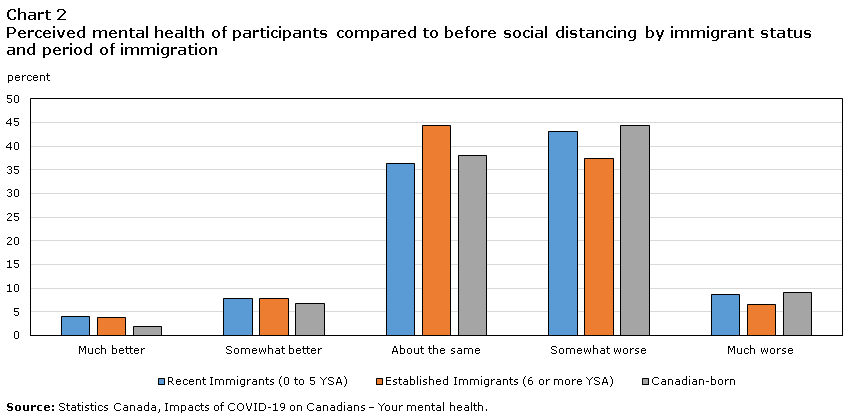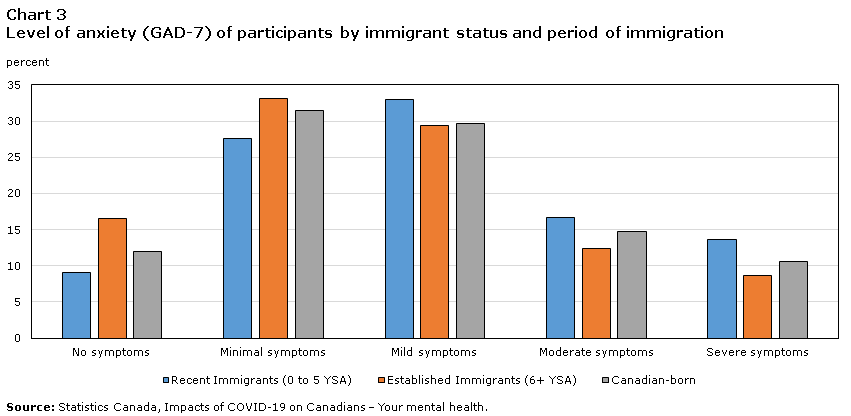 StatCan COVID-19: Data to Insights for a Better CanadaMental Health Status of Canadian Immigrants During the COVID-19 Pandemic
StatCan COVID-19: Data to Insights for a Better CanadaMental Health Status of Canadian Immigrants During the COVID-19 Pandemic
Archived Content
Information identified as archived is provided for reference, research or recordkeeping purposes. It is not subject to the Government of Canada Web Standards and has not been altered or updated since it was archived. Please "contact us" to request a format other than those available.
by Rose Evra and Eric Mongrain
Start of text box

This article provides disaggregated data to better understand the impact of COVID-19 on specific groups. Visit the Gender, Diversity and Inclusion Statistics Hub for more analysis, including disaggregated data on labour, public safety, health and more.
End of text box
In 2016, at the time of the most recent Census, immigrants represented 22% of the overall Canadian population. The April 2020 Labor Force Survey data (Statistics Canada, 2020A) showed that employment among recent immigrants (5 years or less since admission to Canada) and established immigrants (6 or more years since admission to Canada) fell more sharply from February to April (-23% and -17%, respectively) than it did for those born in Canada (-14%). Higher levels of anxiety have been reported among those who have been financially affected by COVID-19, in part due to the impact of the pandemic on their employment situation (Statistics Canada, 2020B). This article examines the impact of COVID-19 on the mental health of immigrants to Canada, and is a part of series on the impact of the pandemic on the mental health of vulnerable groups.
The article uses data from the Statistics Canada Crowdsourcing Survey collected from April 24 to May 11, 2020 "Impacts of COVID-19 on Canadians: Your mental health”. Readers should note that, unlike other surveys conducted by Statistics Canada, crowdsourcing data are not collected using probability-based sampling. Caution should be exercised when interpreting the findings, and no inferences about the overall Canadian population should be made based on these results.
Recent immigrants reported fair or poor mental health more often than other Canadians
Past studies suggest that immigrants, generally, arrive in Canada with better self-perceived mental health than Canadians, but it declines after a period of time in Canada (Salami, 2017). Results from the crowdsource survey suggest the opposite; 28% of recent immigrants who participated in the crowdsourced survey reported fair or poor self-rated mental health, compared to 20% of established immigrant participants and 24% of Canadian-born participants (Chart1). The higher proportion of recent immigrants reporting fair or poor mental health could be related to the pandemic.

Data table for Chart 1
| Excellent or very good | Fair or poor | |
|---|---|---|
| percent | ||
| Recent Immigrants (0 to 5 years since admission (YSA)) | 43 | 28 |
| Established Immigrants (6 or more YSA) | 51 | 20 |
| Canadian-born | 45 | 24 |
| Source: Statistics Canada, Impacts of COVID-19 on Canadians – Your mental health. | ||
Mental health of more than half of recent immigrant participants has worsened since the implementation of physical distancing
Participants were asked how their mental health has changed since the implementation of physical distancing. More than half (52%) of recent immigrant participants indicated that their mental health was either "somewhat worse" or “much worse”, compared to 44% of established immigrant participants and 53% of Canadian-born participants. On the other hand, 12% of recent immigrant and established immigrant participants reported “somewhat better” or “much better” mental health since the implementation of social distancing, compared to 9% for Canadian-born persons. (Chart 2)

Data table for Chart 2
| Much better | Somewhat better | About the same | Somewhat worse | Much worse | |
|---|---|---|---|---|---|
| percent | |||||
| Recent Immigrants (0 to 5 years since admission (YSA)) | 4 | 8 | 36 | 43 | 9 |
| Established Immigrants (6 or more YSA) | 4 | 8 | 44 | 37 | 7 |
| Canadian-born | 2 | 7 | 38 | 44 | 9 |
| Source: Statistics Canada, Impacts of COVID-19 on Canadians – Your mental health. | |||||
Recent immigrant participants more likely to report symptoms of anxiety than other Canadians
The impact of the COVID-19 pandemic can be experienced in many different ways, including feelings of depression, grief, fear, panic, and anxiety, which can be normal responses to situations where day-to-day routines are disrupted and circumstances are uncertain and perceived as potentially risky
(Statistics Canada 2020B). Crowdsource participants were asked about their feelings related to anxiety.
Recent immigrants were more likely to report having experienced at least one symptom of anxiety (91%) in the two weeks prior to completing the survey than established immigrant (82%) and Canadian-born (86%) participants. "Feeling nervous, anxious or on edge" (81%) was the most commonly reported symptom by recent immigrants who experienced at least one symptom of anxiety, followed by "trouble relaxing" (79%) and "becoming easily annoyed or irritable" (78%). These same symptoms were also the most prevalent among established immigrant and Canadian-born participants.
Anxiety was measured using the GAD-7 scale, which is used in population health surveys to identify probable cases of generalized anxiety disorder (GAD), as well as to measure the severity of anxiety symptoms. Recent immigrant participants reported symptoms consistent with moderate to severe generalized anxiety disorder (GAD) more often (30%) than established immigrant (21%) or Canadian-born participants (26%). (Chart 3)

Data table for Chart 3
| No symptoms | Minimal symptoms | Mild symptoms | Moderate symptoms | Severe symptoms | |
|---|---|---|---|---|---|
| percent | |||||
| Recent Immigrants (0 to 5 years since admission (YSA)) | 9 | 28 | 33 | 17 | 14 |
| Established immigrants (6+ YSA) | 16 | 33 | 29 | 12 | 9 |
| Canadian-born | 12 | 31 | 30 | 15 | 11 |
| Source: Statistics Canada, Impacts of COVID-19 on Canadians – Your mental health. | |||||
Female recent immigrant participants are more likely report symptoms of anxiety
Previous surveys related to mental health and gender have demonstrated that women are more likely to report higher levels of fair or poor mental when compared to men (Statistics Canada, 2020C). Among recent immigrant participants, those who identified as female reported symptoms consistent with moderate or severe generalized anxiety disorder (39%) more often than their male counterparts (26%). This is also observed among the established immigrant and Canadian-born participants.
Recent immigrant participants financially affected by the pandemic exhibit higher levels of anxiety
A study from Robert (2012) links the self-reported level of stress of recent immigrants to their income. Recent immigrants (21%) were more likely to agree or strongly agree that they fear losing their job or main source of income when compared to established immigrant (11%) and Canadian-born participants (11%). Of those recent immigrant participants who reported a fear of losing their jobs, 44% reported symptoms consistent with moderate or severe generalized anxiety disorder, versus 19% for those who did not fear losing their jobs. A similar trend is noted for established immigrant and Canadian-born participants. Recent immigrant participants were also more likely to believe that COVID-19 would have a major or moderate impact on their ability to meet their financial obligations (42% compared to 24% for established immigrant participants and 23% for Canadian-born participants).
Previous research suggests that the mental health of young Canadians and of women has been more adversely affected by the pandemic than the mental health of older Canadians and men (Moyser, M. 2020). As such, the age and gender composition of participants in general, and recent immigrant participants in particular, may play a role in their reported mental health outcomes during the COVID-19 pandemic. It is important to note that 31% of recent immigrant participants were under the age of 30 compared to 17% of established immigrant participants and 11% of Canadian-born participants, and 33% recent immigrant participants identified female as their gender, compared to 44% for established immigrants and 52% for Canadian-born participants.
Over the coming weeks, Statistics Canada will continue to report on impacts of the current pandemic among vulnerable populations, including using data from “Impacts of COVID-19 on Canadians: Data Collection Series”, a series of timely crowdsourcing surveys designed to collect information on an ongoing basis on topics related to the COVID-19 pandemic.
Methodology
Data in this release are from Statistics Canada’s questionnaire, “Crowdsourcing: Impacts of COVID-19 on Canadians: Your mental health.” The crowdsourcing questionnaire collects data on the current economic and social situation, as well as on people’s physical and mental health, to effectively assess the needs of communities and implement suitable support measures during and after the pandemic. This alternative information collection method can be used to supplement data obtained from more traditional sources, particularly because of its relatively low implementation cost and its ability to increase the granularity of data in a timely manner. During the April 24 to May 11, 2020, over 46,000 people participated. Methodological adjustments have been made to both groups of participants to account for age, sex and provincial differences.
Generalized anxiety disorder (GAD) is a condition characterized by a pattern of frequent, persistent worry and excessive anxiety about several events or activities. Those with a score of 10 or higher on the GAD-7 were considered to have moderate to severe symptoms of generalized anxiety disorder in the two weeks prior to completing the survey. The data reported do not necessarily reflect a professional diagnosis of GAD. In the context of the COVID-19 outbreak where the population has been unexpectedly exposed to an unprecedented global crisis with wide-ranging impacts including significant disruption to employment, schooling, and routines, and increased health risk, it is important to note that feelings of anxiety can be understood as natural reactions and not necessarily indicators of a long-term mental health disorder.
References
Moyser, M. 2020 “Gender differences in the mental health during the COVID-19 pandemic” Statistics Canada.
Robert, A.-M. 2012 “Mental health and well-being of recent immigrants in Canada: Evidence from the Longitudinal Survey of Immigrants to Canada” Research and Evaluation, IRCC.
Salami, B. 2017 “Mental health of immigrants and non-immigrants in Canada: Evidence from the Canadian Health Measures Survey and service provider interviews in Alberta”.
Statistics Canada. 2020A. “Labor Force Survey, April 2020” The Daily. May 8.
Statistics Canada. 2020B. “Canadians' mental health during the COVID-19 pandemic.” The Daily. May 27. Statistics Canada Catalogue no. 11-001-X.
Statistics Canada. 2020C. “Perceived mental health, population 12 years and over, by sex” Canadian Community Health Survey. Statistics Canada Table no. 13-10-0805-02.
- Date modified:
